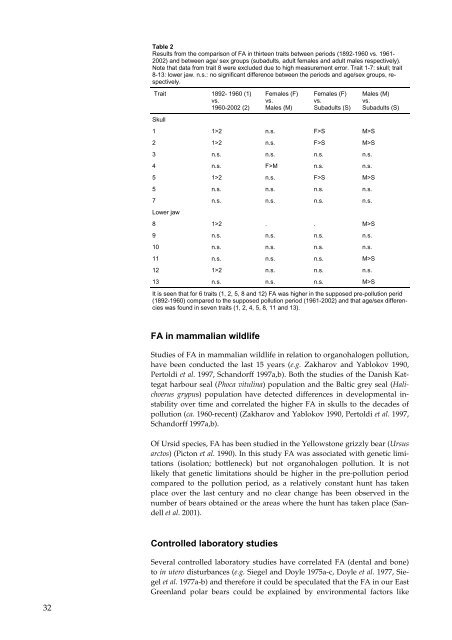Organohalogen concentrations and a gross and histologic ...
Organohalogen concentrations and a gross and histologic ...
Organohalogen concentrations and a gross and histologic ...
You also want an ePaper? Increase the reach of your titles
YUMPU automatically turns print PDFs into web optimized ePapers that Google loves.
32<br />
Table 2<br />
Results from the comparison of FA in thirteen traits between periods (1892-1960 vs. 1961-<br />
2002) <strong>and</strong> between age/ sex groups (subadults, adult females <strong>and</strong> adult males respectively).<br />
Note that data from trait 8 were excluded due to high measurement error. Trait 1-7: skull; trait<br />
8-13: lower jaw. n.s.: no significant difference between the periods <strong>and</strong> age/sex groups, respectively.<br />
Trait 1892- 1960 (1)<br />
vs.<br />
1960-2002 (2)<br />
Skull<br />
FA in mammalian wildlife<br />
Studies of FA in mammalian wildlife in relation to organohalogen pollution,<br />
have been conducted the last 15 years (e.g. Zakharov <strong>and</strong> Yablokov 1990,<br />
Pertoldi et al. 1997, Sch<strong>and</strong>orff 1997a,b). Both the studies of the Danish Kattegat<br />
harbour seal (Phoca vitulina) population <strong>and</strong> the Baltic grey seal (Halichoerus<br />
grypus) population have detected differences in developmental instability<br />
over time <strong>and</strong> correlated the higher FA in skulls to the decades of<br />
pollution (ca. 1960-recent) (Zakharov <strong>and</strong> Yablokov 1990, Pertoldi et al. 1997,<br />
Sch<strong>and</strong>orff 1997a,b).<br />
Of Ursid species, FA has been studied in the Yellowstone grizzly bear (Ursus<br />
arctos) (Picton et al. 1990). In this study FA was associated with genetic limitations<br />
(isolation; bottleneck) but not organohalogen pollution. It is not<br />
likely that genetic limitations should be higher in the pre-pollution period<br />
compared to the pollution period, as a relatively constant hunt has taken<br />
place over the last century <strong>and</strong> no clear change has been observed in the<br />
number of bears obtained or the areas where the hunt has taken place (S<strong>and</strong>ell<br />
et al. 2001).<br />
Controlled laboratory studies<br />
Females (F)<br />
vs.<br />
Males (M)<br />
Females (F)<br />
vs.<br />
Subadults (S)<br />
1 1>2 n.s. F>S M>S<br />
2 1>2 n.s. F>S M>S<br />
3 n.s. n.s. n.s. n.s.<br />
4 n.s. F>M n.s. n.s.<br />
5 1>2 n.s. F>S M>S<br />
5 n.s. n.s. n.s. n.s.<br />
7<br />
Lower jaw<br />
n.s. n.s. n.s. n.s.<br />
8 1>2 . . M>S<br />
9 n.s. n.s. n.s. n.s.<br />
10 n.s. n.s. n.s. n.s.<br />
11 n.s. n.s. n.s. M>S<br />
12 1>2 n.s. n.s. n.s.<br />
13 n.s. n.s. n.s. M>S<br />
Males (M)<br />
vs.<br />
Subadults (S)<br />
It is seen that for 6 traits (1, 2, 5, 8 <strong>and</strong> 12) FA was higher in the supposed pre-pollution perid<br />
(1892-1960) compared to the supposed pollution period (1961-2002) <strong>and</strong> that age/sex differencies<br />
was found in seven traits (1, 2, 4, 5, 8, 11 <strong>and</strong> 13).<br />
Several controlled laboratory studies have correlated FA (dental <strong>and</strong> bone)<br />
to in utero disturbances (e.g. Siegel <strong>and</strong> Doyle 1975a-c, Doyle et al. 1977, Siegel<br />
et al. 1977a-b) <strong>and</strong> therefore it could be speculated that the FA in our East<br />
Greenl<strong>and</strong> polar bears could be explained by environmental factors like

















